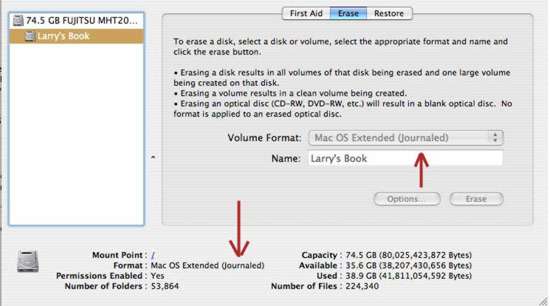
|
White Paper - System Maintenance
|
December 1, 2003
File Journaling
in OSX 10.3 (Panther) Explained
by Larry
Jordan
I'm a post-production consultant to a variety
of broadcast and film production studios throughout Hollywood.
In dealing with my clients, their number one concern is maximizing
the performance of their equipment, while maintaining the highest
level of data integrity.
New to most of us with OS X 10.3 is File
Journaling. First released by Apple in OS
X Server 10.2, this new feature has a direct impact on how
we get maximum performance with maximum safety for our editing
systems.
According to Apple's web site:
"Journaling is a technique that
helps protect the integrity of the Mac OS Extended file systems
on Mac OS X volumes. It both prevents a disk from getting into
an inconsistent state and expedites disk repair if the server
fails.
"When you enable journaling on a
disk, a continuous record of changes to files on the disk is
maintained in the journal. If your computer stops because of
a power failure or some other issue, the journal is used to restore
the disk to a known-good state when the server restarts.
"With journaling turned on, the
file system logs transactions as they occur. If the server fails
in the middle of an operation, the file system can 'replay' the
information in its log and complete the operation when the server
restarts."
Basically, Unix, in order to get improved
performance, keeps disk directories in memory and only periodically
writes them to your hard disk. If you crash, your directories
are, in almost all cases, out of sync with the files recorded
on your hard drives.
Many of us, faced with a system crash,
will use FSCK (or, if the situation is really bad, Disk
Warrior X) to rebuild our directories. However, with OS X
10.3, FSCK no longer works the way it did in 10.2. In fact, it
doesn't work at all. This is because file journaling is turned
on by default in OS X 10.3.
When journaling is turned on, every time
you write a file to your hard disk, or modify an existing file,
the operating system writes an entry into a transaction file.
This is MUCH quicker than writing out the full directory structure.
Journaling is also much safer for your
data because if you crash, the operating system uses the journal
to update the directory structure, which means far less lost
data and far faster reboots.
The problem is that journaling takes
time. Enough time that it is worth considering turning journaling
off on all your media drives. The benefit is that you get faster
performance. The disadvantage is that in the event of a crash,
you don't have the protection journaling provides. On the third
hand, hard drives with journaling turned off are in no worse
shape than hard drives running under OS 10.2.
In my experience with a wide variety
of media clients, disk directory problems almost never arise
with secondary drives, they are almost exclusively the domain
of the boot disk.
As Apple writes:
"If your [computer] contains high-bandwidth
usage data files, such as large video, graphics, or audio files,
you may want to weigh the benefits of using journaling against
the performance needed to access your data. In most cases, the
impact of journaling upon data access performance are unnoticeable
to users, but its implementation may not be practical for [computers]
where data access demands outweigh its benefits."
My recommendation? Leave journaling turned
on for your boot disk and turn it off for all secondary drives
(both internal and external) that are used to store media files.
For external drives that store data, not media, turn journaling
on.
Journaling is controlled using Disk Utility.
And there are two ways you can turn Journaling on (the default)
or off (better for media drives). First, is when you setup your
drive by selecting the appropriate option in the Erase tab.

However, you can also turn off journaling
in the Disk Utility by selecting your hard disk then going to
File->Disable Journaling, which doesn't involve reformatting
your drive and erasing data.
For more technical information on File
Journaling, read Article
ID 107249 on the Apple Support web site.
copyright©Larry Jordan
2003
Larry
Jordan is an Apple-Certified
Trainer in Digital Media with over 25 years experience as an
on-location and studio director and editor with network, local
market and corporate credits. Based in Los Angeles, he's a member
of both the Directors Guild and Producers Guild. Mr. Jordan has
also been recognized as one of the Top 100 Corporate Producers
in America. He's been using Macintosh computers since January
24, 1984, and Final Cut since version 1.0.
This article first appeared on lafcpug and is reprinted here with permission.
All screen captures and textual references are the property and trademark of their creators/owners/publishers.
[Top]




